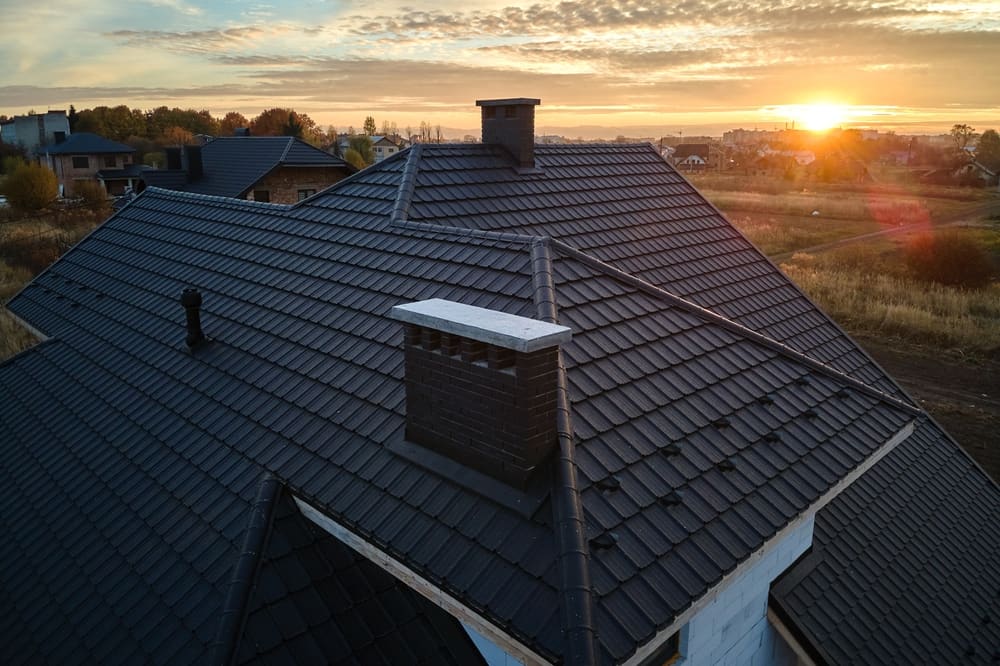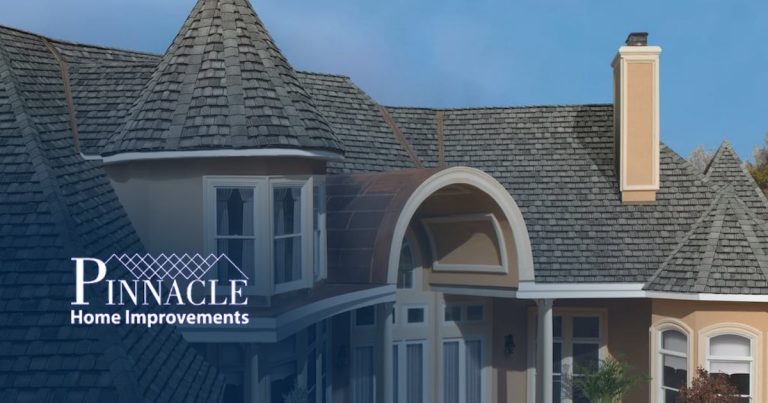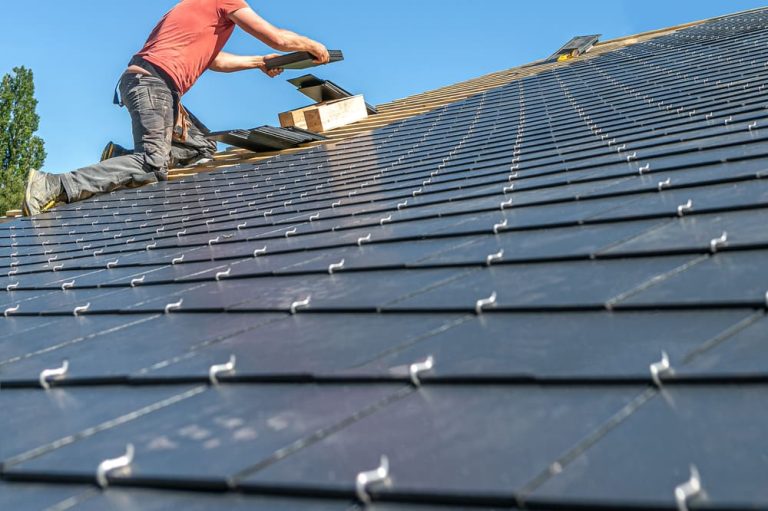If you are considering installing a slate roof, it can be the perfect way to upgrade your home. You’ll not only boost its curb appeal but also your home value. You may ask yourself, “How long do slate roofs last?” Installing slate roofing is well worth it for the enduring qualities it will provide for a lifetime.
Pinnacle Home Improvements wants you to know everything about slate roofing. In our slate roofing installation guide, we explain more about installing slate roofs and why they might be worth the higher upfront cost for these roofing materials.
Materials Used in Slate Roof Installation
Slate roof installation requires a variety of materials. From the slate tiles themselves to the materials fixing them to the roof, you should familiarize yourself with everything your roof will need.
Types of Slate Tiles
Natural Slate
Natural slate is incredibly durable and fireproof. This metamorphic rock has waterproof qualities and provides a naturally beautiful look for your home.
Composite Slate
If you want slate tiles as your roofing material but the cost feels a little out of reach, you may want to consider composite slate tiles. They’re lighter and more affordable, with a composition that melds sustainable materials to create the look of a natural slate roof. Some tiles made from clay, rubber, asphalt, and other materials can be fashioned to look like slate, though they’re less commonly used in slate roof installation.
Supplementary Materials Used When Installing Slate Roofs
When installing slate roofs, there are other roofing materials needed to build the roof deck. Copper nails or stainless steel nails must be used to secure the slate tiles firmly in place. The nails used must be long enough to penetrate the slate thickness.
Over the roof deck, underlayment is installed to provide an additional moisture barrier. If you have a steep roof slope, asphalt-saturated felt is commonly used for underlayment. In addition to a roof’s pitch and the synthetic underlayment materials, flashing is needed around roof penetrations such as chimneys and skylights to prevent leaks.
The roof deck, made from wood or plywood, will be needed to provide support to the slate tiles. Copper is typically used in the valleys to contribute to water runoff for your slate roof. As for other roofing materials, some sealants and other items may be needed to follow installation as per the manufacturer of these materials for enhanced durability.

Preparation for Installing a Slate Roof
Homeowners who are considering a slate roof should know that an inspection must take place first, and then measurements needed for installing slate roofs will help allow for the proper estimate of materials.
Roof Inspections
If you’re replacing your roof with a slate roof, you should understand that these roofing materials weigh considerably more than other materials. A reputable roofing company needs to check to make sure that the roof deck can support the weight of it, especially when choosing thicker tiles.
Should structural issues be detected, the roof needs to be reinforced first. Once the roof is prepared to handle the added weight of slate, old roofing materials must be taken away, and the deck needs to be thoroughly cleaned and readied for the future installation.
Measurement and Ordering of Materials
When the roof is ready for a slate roof, the area must be calculated to determine the number of slate tiles and other materials that need to be delivered to the home for the installation. A reputable roofing company will make a detailed list and estimate the cost of your slate roof to ensure there are no surprises when the work is finished.
How Slate Roofs Are Installed: Step-by-Step Slate Roof Installation Process
In order to properly install a slate roof, the right steps need to be followed. This includes setting up safety measures, installing the underlayment, placing the slate tiles, and finishing it off with inspections to ensure success.
Prioritizing Safety
When you have a slate roof installed, especially one with a steep slope, the roof’s pitch must be accommodated while making sure that all roofing installers have what they need to stay safe. Scaffolding must be secured, and all safety metrics set by the roofing industry must be followed.
Adding Underlayment
After everything is in place to protect the roofers, the underlayment will be placed. This breathable membrane provides waterproof protection on top of the roof deck. It needs to be overlapped and secured, or else it could cause water intrusion into your home.
Install Slate Along the Eaves for the Starter Course
Placing slate tiles begins with specially cut tiles that are placed along the eaves. The starter course gives a secure base to build upon for the rest of the roof.
Placing Battens and Slate Tiles
Next, battens are installed on the roof deck where slate tiles can be nailed in place. Each course is placed to create the right overlap and spacing for the best protection of your home.
Adding Ridge and Hip Tiles
At the peak of the roof, ridge tiles are installed. Hip tiles are installed on angled sections of the roof. Together, they create a watertight seal that protects your home’s interior and creates a stunning finished look.
Installing Flashing
Chimneys, vents, and valleys all need flashing to keep water out. Metal flashing helps give your home the protection it needs to ensure your slate roof lasts for years to come.
Fitting the Slate
Any edges, valleys, or architectural complexities will need slate tiles cut to accommodate and fit snugly around them. This provides a weather-tight fit and a seamless appearance for your home.
Final Inspections
Once every tile and nail head is in place, your slate roof will be cleaned and undergo final inspections. These are the last steps, and with a passing inspection, mean that your roof meets the quality standards set by the industry for the installation of this material.
Maintenance Tips for Slate Roofs
Slate is a durable material that can last for 50 to 100 years, or even longer. Their durability will depend on the precision of installation as well as how you care for your roof over the years.
Conduct Regular Inspections
Ideally, homeowners should inspect their roofs, whether they’re made with slate or other materials, once per year. If a severe weather event blows through your area, you may want to have an additional inspection just to be certain your roof hasn’t been compromised.
You can look for any damaged tiles from the ground or by using a drone. If you see any cracks, breaks, or missing tiles, you should call a professional roofing company for repairs. Similarly, spotting any rust or damage on the flashing surrounding your chimney and vents is an issue that must be dealt with quickly.
Homeowners should always take time to clean out gutters and downspouts, removing debris that can trap moisture. It can reduce your maintenance needs to have gutter guards installed that keep twigs, leaves, and nests out of there to allow for proper water flow.
Even if you don’t see anything amiss yourself, it’s best to have a professional inspection conducted once per year. You can suffer serious injuries by getting on the roof or cause added damage. A professional will also be able to spot damage that you might not notice, and help you to get your roof repaired quickly before the problem worsens.
Cleaning Your Roof
Keeping your roof clean prevents trapping moisture that can cause the materials to deteriorate. If you’re comfortable doing it yourself, you can use a mild detergent to clean your slate and rinse using low pressure from your hose.
Although slate roofs are easier to maintain, it may be best to hire a professional to clean your roof to make sure it’s done correctly and without causing damage. While slate is durable and great at weathering much of what comes its way, it can crack if you don’t use the right methods of care.
Make Repairs Promptly
With a slate roof or any type of roof, it’s imperative to understand that any small issue can worsen into something more serious. If an inspection turns up damage to the slate or flashing, you shouldn’t wait to deal with it. It will only get worse, and the longer you let damage go unrepaired on your roof, the more likely you will be to need much more costly repairs.
Staying ahead of roof damage requires not skipping inspections, keeping your roof clean, and having repairs made right away. If you are thinking about having a slate roof installed as your roof replacement, you will have less to worry about when maintaining it throughout the years, though it will still need your care and attention.
As roofs age, homeowners must be vigilant with upkeep. Roofs provide structural stability and protection for a home. Slate will provide many years of durable protection, though looking after it is the key to protecting your investment, along with the value and appearance of your home. Contact Pinnacle Home Improvements today to learn more about roofs and how they can enhance your home.













